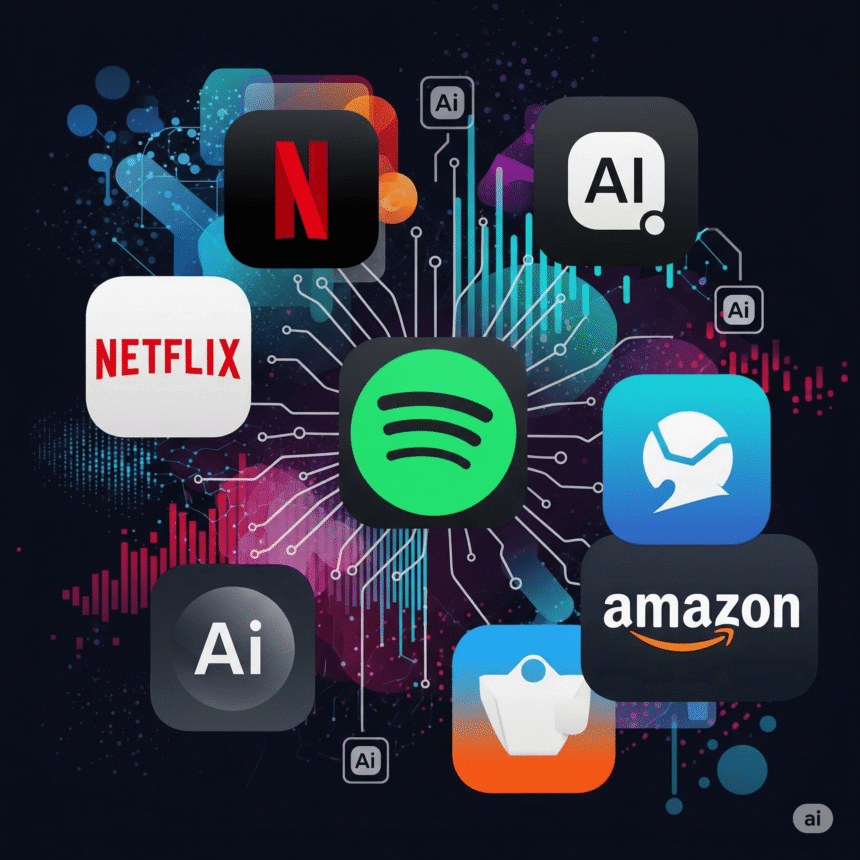Let’s have a quick game. Think back on the last day. Did you use a map to get through the traffic? Did you watch a movie online or listen to a playlist that someone else made? Did you use your face to unlock your phone? Did your bank send you a message about a purchase? If you said yes to any of these, congratulations—you’ve used AI. A lot of times, probably.
For a lot of people, the phrase “artificial intelligence” still brings to mind robots that can think and dystopian sci-fi futures. But the truth about “AI in daily life” is much more subtle, smooth, and already a big part of our lives. The technology we use every day, from the time we wake up until the time we go to sleep, has an invisible engine running in the background. It’s the quiet partner that makes our lives easier, safer, and more unique.
As a tech writer who has been following this revolution, I want to show you what’s behind the scenes. This isn’t a manual for developers or a high-level academic paper. This is a guide for everyone who uses tech. We’re going to look at the most important real-world AI applications that you use every day. We will take the hard things and make them easy to understand, showing you how and why the magic works.
Forget about the distant future; the most amazing AI technology examples are already here, right in front of our eyes. Not only will this article show you how AI is used, but it will also give you useful advice on how to understand and even control its effects on your digital life. Let’s go on a journey to find out what the top five artificial intelligence uses are that are currently changing your life.
1. The Hyper-Personalized Universe: Engines for Recommendations and Content Curation
This is probably the most common and powerful way that people use AI in their daily lives. You are using a smart AI every time you open Netflix, browse Amazon, or scroll through TikTok. Its main job is to get to know you better than you know yourself.
How It Works: The Digital Mind Readers
A recommendation engine is basically a filtering system that guesses what you like. Machine learning, which is a part of AI, looks at huge datasets to find patterns. It looks something like this:
- Data Collection: The AI keeps a close eye on what you do. It keeps track of what you watch, what you skip, when you watch, what device you use, whether you pause, rewind, or re-watch a scene, and even the ads you are most likely to click on. On Amazon, it’s everything you look at, add to your cart, buy, review, or even just hover your mouse over.
- Pattern Recognition (Collaborative Filtering): The AI looks at how you act and compares it to how millions of other people act. It finds “taste clusters,” which are groups of people who watch or buy things in the same way. It then suggests things that other people in your group have liked but you haven’t seen yet. This is the magic of “People who bought this also bought…”
- Content-Based Filtering: The AI also looks at the content itself. It breaks a movie down into thousands of “tags” or metadata points, like the genre, subgenre, actors, director, tone (like “dark,” “quirky,” or “suspenseful”), plot keywords, and more. The AI will actively look for and promote other movies that fit those tags if you watch a lot of “suspenseful sci-fi thrillers starring strong female leads.”
- Continuous Learning: This isn’t something you do once. With every click, view, and purchase, the AI model is always learning more about you and improving its understanding of you. It learns from how you respond. It learns when you don’t follow a suggestion. It learns when you click on it. This constant feedback loop is what makes the suggestions seem eerily correct over time.
What This Means for You in the Real World
The effect is very strong. This AI-driven personalization cuts through the noise of endless options, saving you time. You’d spend hours reading summaries if you tried to find a new movie to watch on Netflix without any suggestions. It helps you find new things, like new artists on Spotify or niche products on Amazon that you would never have found on your own.
But it also makes a “filter bubble” or “echo chamber.” The AI is meant to show you more of what you already like, which can make it harder for you to see new and different points of view or genres. It doesn’t challenge your tastes; it strengthens them.
Tip for everyday life: Help train your AI by being an active participant. Don’t just go along with what other people say.
- Use the “Like/Dislike” buttons: On Netflix, YouTube, and Spotify, you should use the thumbs-up/thumbs-down or rating systems. This gives the AI clear, high-quality information that helps it make better recommendations than just what you watch.
- “Tell Us Why”: Some sites let you click on a recommendation and then choose “Not interested” or “Tell us why.” Use this feature to clean up your digital profile and get rid of any outliers that are messing up the algorithm.
- Make Different Profiles: On sites like Netflix, make different user profiles for different people and for different times of day. To keep your main recommendations from being affected by your viewing habits, make a “Documentary” profile or a “Comfort Movies” profile.
Source Link: The Netflix Technology Blog has a great article that goes into great detail about how Netflix’s recommendation system works.
2. The Unseen Co-Pilot: Smart Navigation and Logistics
AI has completely changed how we get from Point A to Point B. It’s like having a paper map that doesn’t move and a guide that knows what’s going on around you. This is one of the most useful examples of AI technology that we use every day.
How It Works: It’s Not Just a Map
If you type a destination into Google Maps, Waze, or Apple Maps, you don’t just get the fastest way there. You’re talking to a powerful AI that analyzes a huge amount of data in real time.
- Real-Time Traffic Analysis: Crowdsourced data is the most important part of modern navigation. The AI gathers information about the location and speed of millions of other people on the road right now without letting them know. The AI knows there’s a traffic jam when it sees that a lot of phones that usually go 60 mph on the highway are now going 5 mph. By looking at historical data for that time of day and day of the week, it can even guess what traffic will be like before it happens.
- Incident Reporting: The AI uses reports from users about accidents, construction, road closures, and police presence. Waze was the first to do this, adding a layer of information that users create in real time on top of the map.
- Predictive Routing (ETA Calculation): Figuring out your Estimated Time of Arrival (ETA) is a difficult job for AI. It doesn’t just take the speed limit and divide it by the distance. It takes into account the current traffic, the predicted traffic, the historical speed data for each road segment, the timing of traffic lights, and even the type of road. This is why your estimated time of arrival (ETA) can change while you’re on your way.
- Route Optimization: The AI is always looking for other ways to get there. If there is a big accident on your current route, it will quickly look at hundreds of other options, weigh the time saved against the distance added, and suggest a faster route. This kind of complicated problem-solving is a big part of how AI is used in logistics.
How It Affects You in the Real World
Saving time is the most obvious benefit. Every day, millions of people use AI-powered navigation to avoid traffic jams, which saves a huge amount of time and fuel. This has a huge effect on the economy and the environment. It also makes travel less stressful and uncertain. Knowing your ETA and having someone help you get around problems gives you a lot of peace of mind.
This AI technology is what makes our whole on-demand economy work. It’s how Uber and Lyft can quickly find drivers for riders, how DoorDash and Grubhub can make sure your food gets to you hot by finding the best delivery routes, and how Amazon can promise same-day delivery by finding the best routes for all of its delivery trucks.
Tip for Daily Life: Let the AI help you.
- Confirm Incidents: If your navigation app asks if a traffic jam that has been reported is still there, say yes. Your feedback makes the system more accurate for everyone who comes after you.
- Set Your Home and Work: By saving your home and work addresses, you let the app learn how you get to and from work every day. After that, it can send you alerts like, “Traffic is heavier than usual on your way to work. Leave by 7:15 AM to get there on time.”
- Look into different route options: Don’t always take the first route that is suggested. The app may offer choices like “Similar ETA, but fewer turns” or a route that doesn’t use highways. By tapping through these options, you can see how the AI “thinks” and pick the route that works best for your driving style.
3. Voice Assistants and Smart Home Devices: The Digital Butler
Siri, Alexa, and Google Assistant have brought AI into our homes in the form of conversations and sounds. These digital butlers are the most important part of the smart home ecosystem and are a big step forward in real-world AI applications.
How It Works: From Sound Waves to Action
When you say, “Hey Google, what’s the weather today?” A lot of things happen in a very short amount of time.
- Wake Word Detection: The device is always listening, but only for its “wake word,” like “Alexa” or “Hey Siri.” A simple, low-power AI model on the device itself does this. It only knows how to recognize that sound pattern.
- Natural Language Processing (NLP): The device records what you say when you wake up and sends the audio clip to a powerful AI in the cloud. This is where NLP works its magic. The first thing the AI does is Automatic Speech Recognition (ASR), which turns the sound waves of your voice into digital text. It has learned from millions of hours of people talking, with different accents, dialects, and tones.
- Natural Language Understanding (NLU): It’s not enough to just turn your speech into text. The AI now needs to know what you want. It looks at the text (“What’s the weather today?”) to find the main ideas (“weather”) and the purpose (“request for information”). It knows that this is a question that needs information from a weather service. This is a lot more complicated than just searching for a keyword.
- Action and Response Generation: The AI does what you want it to do once it knows what you want. In this case, it asks a weather API about your location. It then uses Natural Language Generation (NLG) to come up with a response that sounds like a person (“The weather in Kigali today is…”) and sends it back to your device to be read aloud.
How This Affects You in Real Life
The main effect is that it is easier to use and get to. Voice assistants have made technology easier for people with disabilities, older people, and anyone else who might have trouble typing on a small screen. You can control your music, set timers, get information, and manage your smart home devices (lights, thermostats, locks) without having to touch anything while you’re cooking, cleaning, or taking care of kids.
This constant interaction is also a huge way to collect data. Every time you ask a question, the AI gets better at understanding both you and human language in general. It powers the smart home ecosystem, making a central hub that can be controlled by voice for more and more connected devices.
Tip for Daily Life: Use your digital butler to its full potential.
- Make Routines: You can make “routines” or “shortcuts” with all major voice assistants. For example, you can make a “Good Morning” routine that tells you the weather, reads your calendar appointments, gives you a traffic update, and starts your smart coffee maker with just one command.
- Check Your Voice History: Every now and then, open your Amazon Alexa or Google Home app and look at your voice history. You can see exactly what the AI heard and get rid of any recordings that make you uncomfortable. This is a good way to protect your privacy and also helps you figure out why the AI might have gotten a command wrong.
- Be Specific: The AI will do a better job if you give it a clear command. “Play some upbeat pop music from the 2010s” is better than “Play some music.” This gives the AI more information to work with and makes it work better.
The Financial Guardian: Finding Fraud and Banking
One of the most useful and hidden uses of artificial intelligence is in the world of finance. AI is a silent guardian that works around the clock to keep your money and financial identity safe from fraud.
How It Works: Finding Anomalies at Scale
Every day, banks and credit card companies handle billions of transactions. People couldn’t keep an eye on all of this activity to look for fraud. This is a great job for AI.
- Creating Your Profile: The AI makes a detailed profile of how you usually spend your money. It knows where you usually shop, how much you spend on average, when you usually shop, what kinds of stores you go to, and even how you shop online (for example, what device you use and where you ship your items).
- Real-Time Transaction Analysis: The AI gets the data from your transactions in real time every time you swipe your card or buy something online. It looks at dozens of factors in a split second:
- Is the place strange? ** (for example, buying something in a country other than your own).
- Is the amount very big? **
- *Is the time of day strange for you?
- Is this a strange kind of merchant? ** (for example, buying something suddenly at a high-end jewelry store when you usually shop at grocery stores).
- Is the speed of the transaction high? ** (for example, buying things in different cities in a short amount of time).
- Anomaly Scoring: The AI gives the transaction a “fraud score” based on how much it differs from what you normally do. An alert goes off if the score goes above a certain level.
- Action and Verification: The AI may automatically cancel the transaction based on the score. If a transaction looks suspicious but isn’t definitely fraud, it might send you a text message or push notification to your phone asking you to confirm the purchase. This is an important part of computer help that keeps you from losing money.
The Effect on You in the Real World
The most important effect is having peace of mind and financial security. AI-powered fraud detection stops billions of dollars’ worth of fake transactions every year, keeping both consumers and banks safe. It’s why you can get a notification almost right away if something is wrong with your account.
This technology also makes it possible to offer personalized financial services. AI helps banks approve loans by better assessing credit risk, gives personalized investment advice through robo-advisors, and powers chatbots that can quickly answer common customer service questions, allowing human agents to focus on more difficult issues.
Tip for Daily Life: Work with the person who looks after your money.
- Set Up Alerts: Open your banking app and make sure you have alerts for transactions turned on. One of the quickest ways to find fraud is to get notifications for every purchase right away.
- Tell Your Bank You’re Going on Vacation: Use your banking app to set a travel notice before you leave the country. This lets the AI know that you plan to buy things in a new country, which stops your card from being incorrectly flagged for fraud and turned down when you really need it.
- Don’t Ignore Verification Texts: If your bank sends you a text asking you to confirm a purchase, do so right away. This feedback teaches the AI and keeps your account safe. Call the number on the back of your card right away if you didn’t buy it.
AI in healthcare and medical imaging: The Digital Doctor’s Assistant
The use of AI in healthcare is probably the most life-changing application on this list, even though it is still a new field. AI isn’t taking the place of doctors, but it is becoming an incredibly useful tool that helps them find diseases earlier and more accurately than ever before. This is one of the most interesting ways that AI is being used for the good of people.
How It Works: Seeing the Unseen in Medical Scans
Medical imaging analysis is one of the most advanced uses of AI in healthcare.
- Training on Huge Datasets: A convolutional neural network (CNN), which is a type of deep learning model, learns from a huge set of medical images, such as X-rays, CT scans, and MRIs. This set of data has thousands or even millions of scans that have already been looked at by professional radiologists and given a diagnosis. The AI learns to connect certain visual patterns, textures, and oddities in the images to certain diseases, such as cancerous tumors, signs of diabetic retinopathy in an eye scan, or signs of Alzheimer’s in a brain scan.
- Pattern Recognition at a Pixel Level: The AI can look at pictures in a way that is much more detailed than what a person can do. It can find tiny patterns, small changes in tissue density, and combinations of factors across millions of pixels that the human eye might not be able to see.
- Highlighting Areas of Interest: When the AI gets a scan of a new patient, it doesn’t just say “yes” or “no.” It looks at the picture and points out certain areas of concern, which basically tells the human doctor where to look for the most suspicious things. For example, it might give a probability score, like “There is a 92% chance that this nodule is cancerous.”
- Adding to the Expert: The human radiologist looks over the AI’s results. The AI is like a “second pair of eyes,” catching things the human might have missed, especially after reading hundreds of scans all day. This mix of human knowledge and AI accuracy makes diagnoses faster and more accurate.
How It Affects You in Real Life
The effect could save lives. Finding diseases early on is very important for treating them, especially cancer. AI can greatly improve patient outcomes and survival rates by finding diseases in their earliest stages. It can also speed up the process of making a diagnosis, which means patients don’t have to wait as long and can start treatment sooner.
AI is also being used to look at patient data to figure out how likely they are to get sick, to find new drugs and treatments by looking at molecular structures, and to power wearable devices that keep an eye on chronic conditions like diabetes and heart disease in real time.
Tip for Daily Life: Even if you don’t talk to this AI directly, you can still be a proactive patient.
- Ask Your Doctor: When you have a medical scan, don’t be afraid to ask your healthcare provider if AI-assisted diagnostic tools were used in their analysis.
- Embrace Wearable Tech: If you have a long-term illness, ask your doctor how the data from your smartwatch or other wearable devices can help keep an eye on your health. AI is now used by a lot of wearables to find problems like an irregular heart rhythm (atrial fibrillation).
- Help with Medical Research: You can give your permission for your anonymous medical data to be used to train the next generation of AI models at many research institutions. This will help make healthcare better for everyone.
The American Journal of Roentgenology often publishes research on how AI can be used in medical imaging and how well it works.
The End: Accepting Your Future with AI
Artificial intelligence is no longer just a theory. It is used in hospitals to save lives and in our homes to provide personalized entertainment. They are useful, personal, and strong. AI in daily life is the invisible thread that connects the most common things we do. It is an unseen force that makes our world more efficient, safe, and personalized.
We have seen how AI can be our personal DJ, our co-pilot who helps us beat traffic, our always-there home assistant, our watchful financial security guard, and our doctor’s super-powered assistant. These real-world AI uses are only the start. As technology gets better, AI will become even more a part of our lives. It will power everything from personalized education for our kids to new discoveries in climate science.
The most important thing is to not be afraid of this technology but to learn about it. By noticing the AI technology examples around you and using the useful tips we’ve talked about, you go from being a passive user to an active participant. You can teach the algorithms to do a better job for you, keep your privacy safe, and understand how complicated it is to make even the simplest clicks and commands work. The AI revolution isn’t coming; it’s already here. And now you know exactly where to look for it.
Questions and Answers (FAQ)
Q: Will AI take my job?
A: Most experts agree that AI will automate many tasks, but it will probably be used to make things better rather than replace most jobs. It will probably change jobs, requiring new skills and letting people focus on tasks that need creativity, critical thinking, and emotional intelligence—things that AI still has trouble with.
Q: Is the AI in my devices always listening to me?
A: Smart speakers are always listening for their “wake word,” but they don’t record or send anything to the cloud until they hear that word. That being said, privacy is a real concern, so it’s a good idea to check the privacy settings and voice history in the companion app for your device.
Q: Is it possible for me to opt out of these AI systems?
A: Yes, but it’s getting harder and harder to do so. You can turn off personalization on a lot of services, but this usually makes the product less useful. You can avoid having your finances tracked by using cash instead of cards. But for many basic internet services, like search and navigation, interacting with the AI is an important part of the service itself.
Q: What can I do to learn more about AI?
A: There are a lot of great, easy-to-find resources online. There are articles that are easy to understand on websites like Google AI and IBM’s AI Explained. Coursera and edX are two places where you can find free introductory courses from top universities.
https://diolichat.rw/technology/aiartificial-intelligent
https://diolichat.rw/technology




